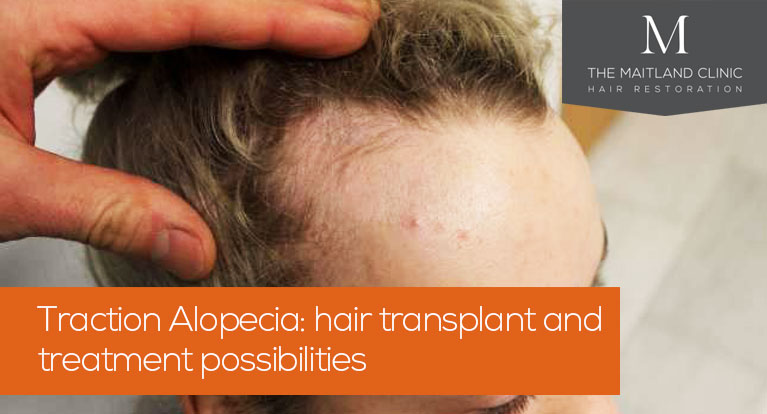Traction Alopecia: hair transplant & treatment possibilities
25th September 2023

Traction alopecia is a type of hair loss that’s caused by constant pulling on the hair follicles, often as a result of wearing tight or restrictive hairstyles. At The Maitland Clinic, we’re often asked questions such as ’How can traction alopecia be treated?’ and ‘Do hair transplants work for traction alopecia?’. In this post, we look at the various treatment possibilities for traction alopecia and how we can help, including the cost of a traction alopecia hair transplant.
Treatment options for traction alopecia can include topical solutions like minoxidil or antibiotics, steroid injections and, in more advanced cases, a traction alopecia hair transplant. If the condition is in the very early stages, simply eliminating the underlying source of the tension may be sufficient to reverse the hair loss.
What is traction alopecia?
Traction alopecia refers to hair loss that occurs when the hair is put under sustained tension. In many cases, this tension is due to wearing tight hairstyles like braids, cornrows, ponytails and buns. Weaves and hair extensions can also put too much stress on the hair follicles, as can certain types of hair accessories and headwear.
This continuous strain can damage or even destroy the hair follicles, eventually leading to bald spots or a receding hairline. The good news is traction alopecia is usually treatable, but it’s important to seek help as soon as possible.
You can find out whether it’s ever too late to treat traction alopecia here.
How is traction alopecia treated?
The best treatment for traction alopecia will depend on how advanced the condition is. In the very early stages, you can often reverse the effects of traction alopecia by simply changing your behaviour. However, if the tension has been present for some time, you may need to consider additional treatment options such as minoxidil or even a hair transplant.
Behavioural changes
The first step in any treatment plan is to identify and eliminate the source of the tension. For example, if your hair loss is being caused by a tight hairstyle, you’ll need to switch to a looser style that’s gentler on the hair follicles. You should also avoid anything that can damage or weaken your hair such as chemical relaxants, dyes and heated styling tools.
Once you’ve removed the underlying cause, your hair may start to regrow and recover over the following months. However, if your hair follicles are badly damaged and there’s extensive scarring, you may need to consider other treatment options.
Topical minoxidil
As well as changing your habits, applying a topical solution such as minoxidil can also encourage new hair growth. Minoxidil works by helping blood flow to the hair follicles, stimulating and prolonging the hair growth phase. It’s available in a foam or liquid form which is massaged directly into the scalp and also as a low dose oral tablet.
Antibiotics
If your scalp is severely inflamed, you might be prescribed antibiotics to help prevent infection.
Steroid creams or injections
Steroid-based creams and lotions are sometimes used to reduce redness and itching. Alternatively, steroid injections may be administered to help reduce soreness and inflammation in the affected area. However, it’s worth noting that long-term use of steroid-based treatments can cause the skin to become thinner and lighter.
A traction alopecia hair transplant
If your hair follicles are severely scarred, the above measures may not be enough to reverse the hair loss. In this case, a hair transplant may be the only option. During hair restoration surgery, healthy hair grafts are harvested from one part of the head and then transplanted into the areas affected by hair loss. The two main hair transplant techniques are known as Follicular Unit Excision (FUE) and Follicular Unit Transplant (FUT).
If you’re worried about traction alopecia, we can assess your condition and discuss potential treatment options with you. Get in touch with our team today.
Do hair transplants work for traction alopecia?
Undergoing a hair transplant is an effective way of restoring hair in areas where it’s been permanently lost due to traction alopecia. Both the FUE and FUT methods can achieve great, natural-looking results. However, for any hair transplant to work, it’s important to follow the advice of your surgeon and stop any behaviours that may be contributing to the hair loss.
The transplanted grafts are very fragile for the first few postoperative days, so you’ll also have to be careful not to damage or dislodge them. As a patient of The Maitland Clinic, we’ll give you everything you need to look after your grafts following your surgery, including instructions on sleeping and washing your hair. You can read more about our aftercare service here.
What to expect during a hair transplant for traction alopecia
At The Maitland Clinic, we can perform FUE and FUT surgery on patients with advanced traction alopecia. Both of these techniques involve taking healthy hair grafts from one part of the scalp (the donor site) and placing them into tiny incisions in the areas affected by hair loss. The main difference between the two methods is how the grafts are harvested.
If you’re considering a hair transplant for traction alopecia, here’s a quick breakdown of what to expect:
FUE for traction alopecia
During an FUE procedure, the donor area of the scalp is shaved and follicular unit grafts are excised individually using a 0.8mm to 1mm ‘punch’. The procedure can either be carried out manually or with a motorised surgical tool. These healthy grafts are taken from an area of the scalp where hairs are genetically programmed to grow for life (usually at the back of the head).
After the grafts are harvested, our surgeon, Dr Edward Ball, makes microscopic slits in the recipient area of the patient’s scalp. In doing so, he pays extreme care and attention to the positioning of the incisions to ensure they blend seamlessly with the patient’s native hair. The individual grafts are then placed into these recipient sites by our highly skilled team of surgical assistants.
Following FUE surgery, there will be a series of tiny dot scars in the donor area of the scalp, but these are so small as to be scarcely noticeable. You can read more about the FUE process here.
FUT for traction alopecia
Also known as ‘strip’ surgery, FUT is an established hair transplant technique in which the surgeon removes a strip of skin from the donor area of the scalp, usually at the back of the head. This strip is placed under high-powered microscopes and then divided into tiny grafts of individual follicular units comprised of one to four hairs. The site of the donor strip is stitched closed before being covered by the surrounding hair.
Again, Dr Ball makes tiny incisions in the recipient area of the scalp, drawing on his technical skill and exceptional artistry to create a great, natural-looking result that’s unique to each patient. Well documented examples of Dr Ball’s artistry and his ability to recreate incredibly natural-looking hairlines can be seen in our female hair transplant results gallery.
The stitches are removed around 10-14 days after surgery and the donor area heals to form a linear scar. You can read more about the FUT process here.
How much does a hair transplant cost for traction alopecia?
The cost of a hair transplant varies from patient to patient and you’ll need to have an in-person consultation to determine the exact price. As a rough guide, at The Maitland Clinic prices start at £3,500, with the average cost of a procedure between £6,000-£7,000.
Get help for traction alopecia
We have an excellent record of treating patients with traction alopecia. This includes performing successful FUE and FUT hair transplants on patients who have suffered permanent hair loss.
The Maitland Clinic is led by Dr Edward Ball, who is widely acknowledged to be one of the leading hair restoration surgeons in the world, renowned for the naturalness of his transplanted hairlines. He takes time to develop a hair design that’s bespoke to you in order to create natural results that will serve you for a lifetime.
You can view our results in our online gallery.
To arrange a consultation at The Maitland Clinic, please call 02392 706122 or email us at enquiries@themaitlandclinic.com.










